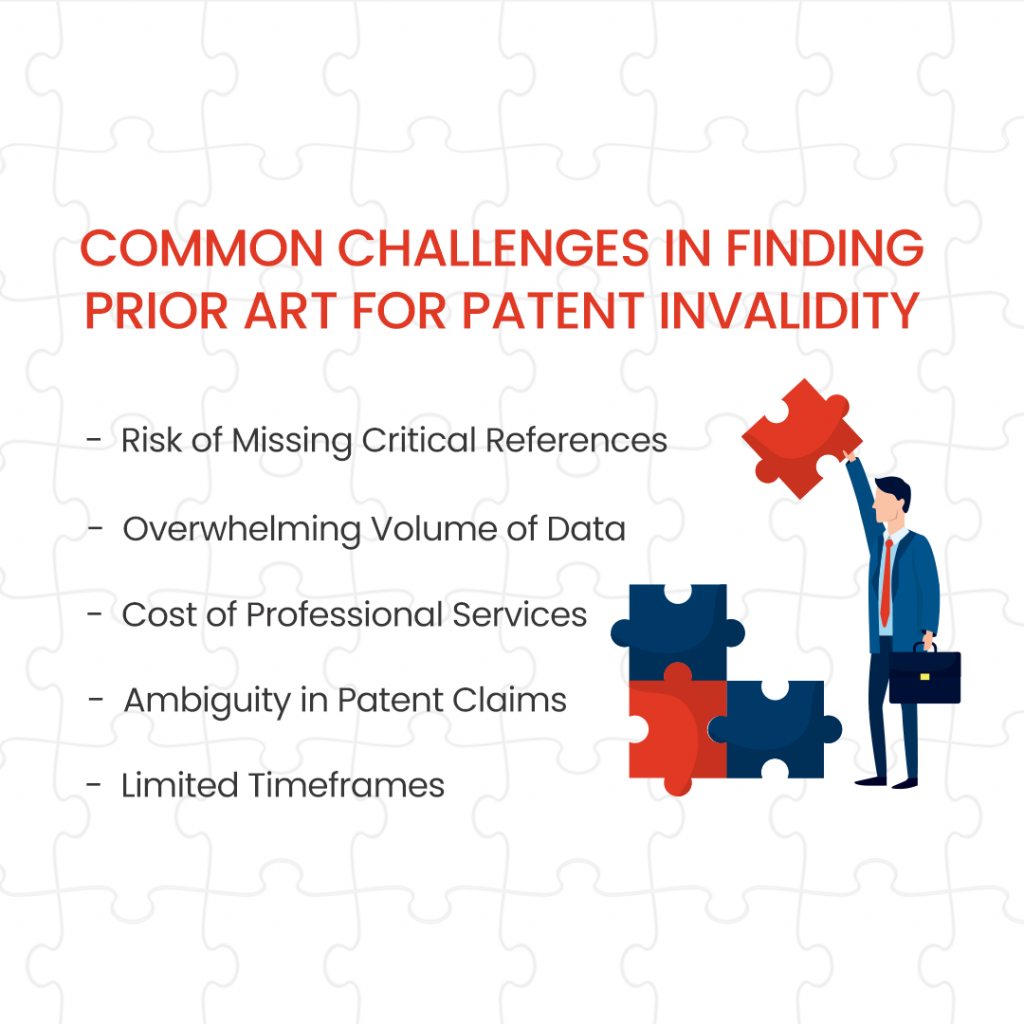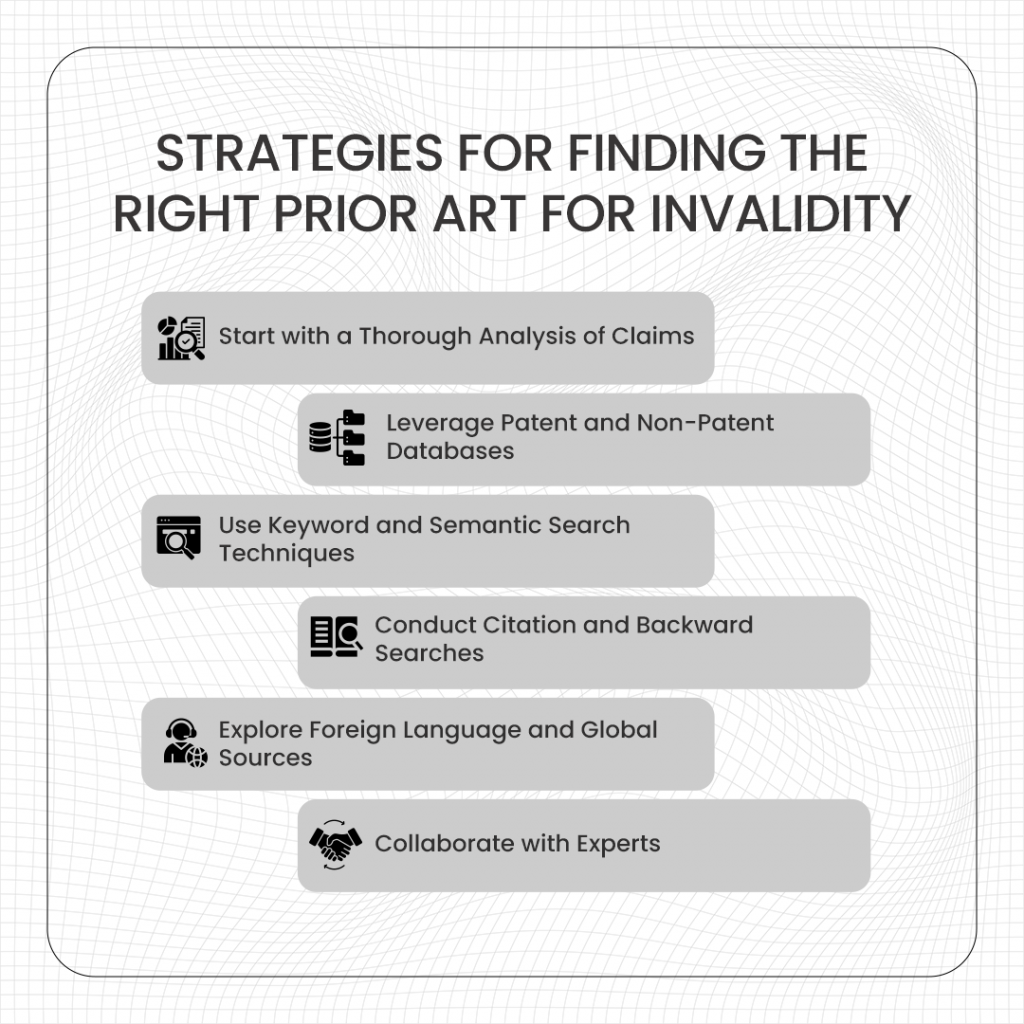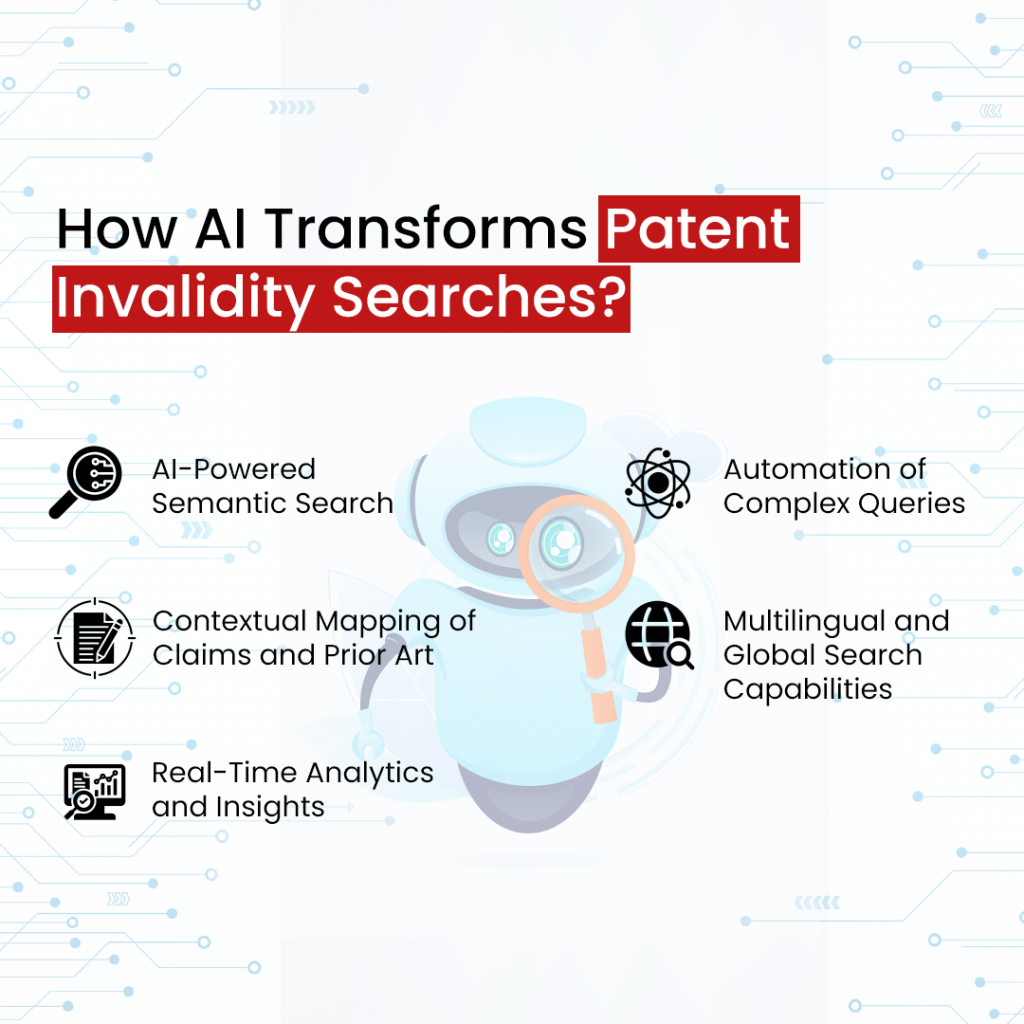
Introduction
Prior art is the backbone of patent invalidity cases. It plays a critical role in determining whether a granted patent truly meets the requirements of novelty and non-obviousness.
In litigation or opposition proceedings, uncovering the right prior art can be the difference between a successful invalidation and a failed challenge. It’s not just about identifying any prior art—it’s about finding the most relevant and impactful references that directly challenge the patent claims.
However, the process of finding such prior art is far from straightforward. With millions of patents and non-patent literature scattered across industries, languages, and jurisdictions, the sheer volume of data is overwhelming.
Add to that the complexities of interpreting vague or overly broad patent claims, and the task becomes even more challenging. Traditional search methods often fall short, requiring extensive time and effort, while leaving room for errors or missed references.
This blog aims to simplify the process by providing expert strategies and actionable insights for conducting effective prior art searches for patent invalidity. From understanding the nuances of claims to leveraging AI-powered tools, we’ll guide you through the steps to find the right prior art like a pro.
Whether you’re an innovator, attorney, or IP professional, mastering these techniques can save time, reduce costs, and improve your chances of success in invalidation cases.
Understanding Patent Invalidity
Patent invalidity is a crucial concept in intellectual property law, particularly in litigation and opposition proceedings. It refers to the process of challenging the validity of a granted patent by demonstrating that it fails to meet the legal requirements of patentability, such as novelty and non-obviousness.
Invalidating a patent can protect businesses from wrongful infringement claims, clear the path for innovation, or provide leverage during disputes.
What is Patent Invalidity?
Patent invalidity is the process of legally proving that a patent should not have been granted because it does not meet the established criteria for patent protection.
Why It Matters in Litigation and Opposition:
Invalidity is often raised as a defense in infringement lawsuits, where the accused party argues that the asserted patent is invalid and, therefore, unenforceable. It is also a key strategy in opposition proceedings, where a competitor challenges a patent shortly after it is granted.
Critical Scenarios for Invalidity Searches:
- Freedom-to-Operate (FTO): Ensures that a product or process does not infringe on existing patents by invalidating potentially obstructive patents.
- Competitor Analysis: Helps identify weak patents held by competitors that could be invalidated to reduce their competitive edge.
- Costly Infringement Lawsuits: Invalidating a patent can help businesses avoid damages or injunctions resulting from infringement claims.
In these scenarios, identifying the right prior art is vital to building a strong invalidity case.
Key Legal Standards for Invalidity
Two main criteria govern patent invalidity: novelty and non-obviousness. Understanding these standards is essential for shaping an effective prior art search strategy.
Novelty:
Novelty requires that an invention must be entirely new and not disclosed in any prior art before the patent application’s filing date.
- Role of Prior Art: If a single piece of prior art (e.g., a patent, publication, or publicly disclosed information) fully discloses the claimed invention, the patent can be invalidated on the grounds of lacking novelty.
Non-Obviousness:
Non-obviousness requires that the invention must not be an obvious improvement or combination of existing technologies to someone skilled in the art.
- Role of Prior Art: A combination of multiple prior art references can be used to argue that the claimed invention was obvious and, therefore, unpatentable.
Understanding these legal standards shapes how and where you search for prior art. For novelty, the focus is on finding a single, comprehensive reference, while for non-obviousness, it involves identifying combinations of prior art that render the claims obvious.
By aligning your prior art search strategy with these legal requirements, you can build a stronger case for invalidating patents and navigating complex IP disputes effectively.
Common Challenges in Finding Prior Art for Patent Invalidity

Conducting patent invalidity searches is a complex and demanding process. Innovators and attorneys face several challenges, ranging from data overload to tight deadlines.
Here are the most common obstacles encountered during patent invalidity searches and why they can be so difficult to overcome.
1. Overwhelming Volume of Data
The sheer amount of patent and non-patent literature available today makes prior art searches for patent invalidation incredibly challenging.
- Navigating Vast Databases: With millions of patents filed globally each year and an ever-growing volume of research papers, technical documents, and product literature, sifting through this data is overwhelming.
- Lack of Centralized Access: Patent information is often spread across various databases, each with different formats, interfaces, and search functionalities. Combining this with non-patent literature adds another layer of complexity. The inability to access all relevant data in one place increases the risk of missing crucial references.
2. Ambiguity in Patent Claims
Patent claims are often written in highly technical or vague language, making it difficult to pinpoint the scope of protection.
- Broad Claims: Claims written in broad terms can overlap with numerous existing technologies, making it harder to determine what specific features to target during a prior art search.
- Vague or Ambiguous Language: Patents often use generic or unclear terms to describe inventions, leaving room for multiple interpretations. This ambiguity complicates the process of finding prior art that directly challenges the claims.
Understanding the exact scope of the claims requires a meticulous review, which can be time-consuming and prone to human error.
3. Limited Timeframes
Time is a critical factor in patent invalidity searches, particularly during litigation or opposition proceedings.
- Tight Deadlines: In legal cases, teams often have limited time to find prior art that invalidates a patent. The need for speed can compromise the depth and accuracy of the search.
- Pressure to Deliver Results Quickly: Balancing thoroughness with urgency is a significant challenge. Missing deadlines can weaken the case and limit opportunities to present compelling evidence.
The time constraints increase the reliance on experienced professionals and advanced AI patent invalidity search tools to accelerate the process without sacrificing quality.
4. Risk of Missing Critical References
The consequences of overlooking important prior art can be severe, potentially leading to failed invalidation attempts.
- Human Limitations: Manual searches, even by experienced professionals, are prone to oversights. Subtle variations in terminology or differences in classification can result in critical references being missed.
- Hidden Prior Art: Some prior art may not be immediately obvious, such as older patents written in outdated language or non-patent literature buried in technical archives.
A missed reference could mean the difference between invalidating a patent and failing to prove your case, making this one of the most pressing challenges.
5. Cost of Professional Services
Hiring patent experts, attorneys, and technical specialists for patent invalidity searches can be expensive.
- High Costs of Expertise: Comprehensive searches require professionals with specialized knowledge in patent law, technical fields, and prior art databases. Their services often come at a premium.
- Financial Burden for Startups: Smaller businesses and individual inventors may struggle to afford such services, limiting their ability to conduct robust searches.
The financial strain is further compounded when repeated searches are required to refine findings or address missed references.
These challenges highlight why finding prior art for patent invalidity is a demanding process. From navigating massive datasets to interpreting ambiguous claims under tight timeframes, every step presents obstacles that require strategic thinking and the right tools.
Addressing these challenges is crucial to ensuring successful invalidity outcomes, and advancements in AI are now emerging as a solution to help overcome these hurdles.
Strategies for Finding the Right Prior Art for Invalidity

Finding the right prior art for invalidating a patent is a complex and strategic process. It requires a deep understanding of the claims, access to various databases, and the right techniques to uncover relevant references.
Below are proven strategies to enhance the effectiveness of prior art searches for invalidity cases.
1. Start with a Thorough Analysis of Claims
Before diving into databases, it’s crucial to analyze the claims of the patent you want to invalidate.
- Break Down the Claims into Key Features: Dissect the claims into individual components or technical elements. For example, if the claim describes a “heat-resistant polymer for medical devices,” identify keywords like “heat-resistant,” “polymer,” and “medical devices” as distinct features.
- Understand the Scope of the Claims: Determine whether the claims are broad or narrow. Broad claims often require searches across multiple fields, while narrow claims allow for more focused research. This understanding helps in targeting the most relevant prior art.
A strong analysis of the claims ensures that the search remains precise and aligned with the patent’s critical features.
2. Leverage Patent and Non-Patent Databases
Searching across multiple databases is essential for comprehensive coverage.
- Patent Databases: Use specialized platforms like XLSCOUT, USPTO, EPO, WIPO, and Google Patents to access global patent repositories. These databases often offer advanced search features to refine results.
- Non-Patent Literature: Many groundbreaking innovations are documented outside patents, such as in research papers, technical manuals, white papers, product catalogs, or even presentations. Platforms like XLSCOUT’s proprietary database and other industry-specific archives can provide valuable prior art.
Using both patent and non-patent literature expands the scope of your search, increasing the likelihood of uncovering impactful references.
3. Use Keyword and Semantic Search Techniques
Keyword-based searching is foundational in identifying relevant prior art, but it requires careful planning and execution.
- Develop a Comprehensive List of Keywords: Use synonyms, variations, and industry-specific terms related to the claims. For example, for “self-driving cars,” include terms like “autonomous vehicles,” “driverless cars,” and “robotic vehicles.”
- Semantic Searching: Leverage AI patent invalidation search tools for semantic searching.
4. Conduct Citation and Backward Searches
Examining the citation network of a patent can reveal highly relevant prior art.
- Review Cited References: Check the references cited in the patent under review. These are often foundational documents that may overlap with the claims.
- Perform Backward Citation Searches: Explore prior patents and literature that cited the target patent after its publication. This backward-looking approach can uncover related innovations that challenge the novelty or non-obviousness of the claims.
Citation analysis often provides valuable insights into the technical lineage of the invention, helping you identify critical prior art.
5. Explore Foreign Language and Global Sources
Innovation is a global phenomenon, and critical prior art often resides in international patents or documents.
- Utilize Multilingual Search Capabilities: Many databases, like XLSCOUT and WIPO, offer multilingual search tools. Additionally, some AI patent invalidity analysis tools provide semantic search capabilities across languages.
- Leverage Translation Tools: Use machine translation tools like Google Translate or AI-powered solutions to analyze patents and documents in foreign languages. For example, a breakthrough invention in Japan or Germany might hold the key to invalidating a patent in another jurisdiction.
Expanding your search globally ensures that no relevant prior art is overlooked due to language or geographic barriers.
6. Collaborate with Experts
Effective prior art searches often require insights from professionals with specialized knowledge.
- Consult Subject-Matter Experts: Professionals with technical expertise in the relevant industry can help identify subtle overlaps between prior art and claims. For instance, an expert in polymer science may identify prior art that generalists might miss.
- Work with Legal Professionals: Patent attorneys and search professionals can refine strategies and ensure that the search aligns with the legal standards for invalidity.
- Partner with Technical Specialists: For highly specific industries (e.g., medical devices or AI systems), engaging a technical specialist or consulting with a patent invalidation search services provider ensures you’re searching in the right places and using the right terminology.
Collaboration enhances the depth and accuracy of the search, helping to build a stronger invalidity case.
Finding the right prior art for patent invalidity requires a combination of thorough analysis, advanced search techniques, and expert collaboration.
Whether you’re a seasoned attorney or an innovator handling invalidity for the first time, these strategies will help you conduct more effective and efficient patent invalidation searches, setting the foundation for a successful invalidation case.
How AI Transforms Patent Invalidity Searches?

Artificial Intelligence (AI) is revolutionizing the process of prior art searches for patent invalidity. By leveraging cutting-edge technologies like Large Language Models (LLMs) and Generative AI, automated patent invalidation search tools enhance accuracy, reduce effort, and accelerate results.
Here’s how AI is transforming the way innovators and attorneys handle invalidity cases.
1. AI-Powered Semantic Search
One of AI’s most significant advancements is its ability to go beyond traditional keyword-based searches through semantic understanding.
- Understanding Context Beyond Keywords: Unlike traditional search methods that rely on exact matches, AI-powered semantic search comprehends the meaning behind the words. For example, if the claim involves “autonomous vehicles,” semantic AI recognizes related terms like “self-driving cars” or “driverless transportation,” ensuring relevant prior art is not missed due to terminology differences.
- Deeper Connections in Claims: AI evaluates the intent and context of claims, identifying nuanced overlaps between an invention and prior art. This capability ensures that even hidden or less obvious references are surfaced, which is crucial for building strong invalidity cases.
Semantic search improves the comprehensiveness of results and significantly reduces the time spent on refining search queries manually.
2. Automation of Complex Queries
AI eliminates the need for manually crafting complex Boolean search queries, saving time and reducing errors.
- Generating Accurate Queries Automatically: AI patent invalidity tools can interpret claims and automatically generate advanced search queries that capture all critical elements. This removes the guesswork and ensures that searches are both precise and exhaustive.
- Dynamic Query Refinement: Based on initial results, AI refines and adjusts search parameters in real time, filtering out irrelevant data and prioritizing high-value references.
This automation frees up attorneys and innovators to focus on analysis and strategy rather than spending hours building and tweaking queries.
3. Contextual Mapping of Claims and Prior Art
AI-powered patent invalidity search tools excel at mapping patent claims to relevant features within prior art, offering unmatched precision in invalidity searches.
- Linking Claims to Specific Features: AI evaluates the technical features in claims and connects them to corresponding elements within prior art documents. For example, if a claim focuses on “thermal conductivity of materials,” AI identifies prior art with specific data on thermal conductivity measurements or materials testing.
- Streamlining Targeted Invalidations: By highlighting the exact overlaps or contradictions between claims and prior art, AI enables users to build more targeted invalidity arguments.
This capability ensures that critical references are not just found but contextualized, making them more effective in invalidation cases.
4. Multilingual and Global Search Capabilities
Patent innovation knows no borders, and relevant prior art often exists in different languages and jurisdictions. AI bridges these gaps effortlessly.
- Breaking Language Barriers: AI uses advanced machine translation and cross-lingual semantic understanding to search for prior art in multiple languages. For example, a Japanese patent on robotics might hold key prior art for a U.S. invalidity case, and AI ensures it is accessible without language limitations.
- Global Data Integration: AI scans patents and non-patent literature from international databases, ensuring comprehensive coverage. This capability is particularly important for multinational invalidity cases where jurisdiction-specific prior art can make a difference.
By making global and multilingual searches seamless, AI ensures no relevant reference goes unnoticed due to language or geographic boundaries.
5. Real-Time Analytics and Insights
AI doesn’t just provide search results—it delivers actionable insights that enhance decision-making in invalidity cases.
- Evaluating the Strength of Prior Art: AI tools analyze the relevance, novelty, and potential impact of prior art references on the targeted claims. This helps users quickly assess which references are worth pursuing further.
- Interactive Dashboards: AI provides visualizations and analytics that summarize search results, helping attorneys and innovators identify patterns or gaps in prior art.
- Adapting to Changing Strategies: AI patent invalidity search tools can offer real-time recommendations for modifying search strategies based on initial findings, ensuring searches remain focused and productive.
These insights transform invalidity searches into a more strategic, data-driven process, saving time while increasing the likelihood of success.
AI is revolutionizing prior art searches for invalidity by addressing the limitations of traditional methods. Through semantic search, automation, contextual mapping, multilingual capabilities, and real-time insights, AI empowers users to uncover critical references more efficiently and effectively.
For attorneys and innovators navigating patent invalidity cases, AI is not just a tool—it’s a strategic ally that reduces manual effort, enhances accuracy, and accelerates the path to invalidating weak patents.
By integrating AI into their workflows, professionals can confidently tackle even the most complex invalidity searches and achieve better outcomes.
How XLSCOUT’s Invalidator LLM Simplifies Patent Invalidity Searches?
XLSCOUT’s Invalidator LLM is a state-of-the-art AI-powered tool designed to transform the way prior art searches for invalidity are conducted. Built on advanced Large Language Models (LLMs), it leverages semantic search capabilities and claim mapping to deliver faster, more accurate, and comprehensive results.
Whether it’s finding hidden references or identifying connections between claims and prior art, Invalidator LLM ensures that innovators and attorneys have the data they need to build strong invalidation cases.
Benefits for Innovators and Attorneys
XLSCOUT’s Invalidator LLM offers several benefits that address the biggest challenges of traditional invalidity searches:
- Thorough and Accurate Results: Its semantic search capabilities go beyond keyword matches, understanding the context of claims and uncovering nuanced prior art that may otherwise be missed.
- Efficient and Time-Saving: By automating complex query generation, Invalidator LLM drastically reduces the time spent on manual search iterations, enabling users to focus on analysis and strategy.
- Contextual Claim Mapping: The tool links specific features of a claim to relevant prior art, streamlining the process of building targeted invalidation arguments.
- Cost-Effective Solution: By reducing reliance on external experts and cutting down search time, Invalidator LLM provides a budget-friendly alternative for businesses of all sizes.
For example, an attorney handling a high-stakes invalidation case can use Invalidator LLM to identify critical prior art across multiple jurisdictions in a fraction of the time required by traditional methods.
If invalidity searches feel overwhelming, it’s time to embrace a smarter approach. XLSCOUT’s Invalidator LLM simplifies the process, ensuring accuracy, efficiency, and confidence in your results.
Conclusion
Finding the right prior art for patent invalidity is essential to challenge weak patents effectively and ensure strong intellectual property strategies. However, the process comes with its fair share of challenges—navigating massive data volumes, interpreting ambiguous claims, working under tight deadlines, and managing high costs.
These obstacles make traditional patent invalidity searches time-consuming, error-prone, and expensive.
By adopting advanced strategies such as claim analysis, leveraging diverse databases, conducting citation searches, and exploring global sources, innovators and attorneys can improve their search processes.
However, the true game-changer lies in integrating AI patent invalidation search tools into these workflows.
AI patent invalidation analysis software like XLSCOUT’s Invalidator LLM take this transformation even further by automating complex tasks, understanding claim contexts, and identifying impactful prior art with precision.
By reducing manual effort and delivering reliable insights, Invalidator LLM empowers innovators and attorneys to conduct patent invalidity searches like pros, saving time and costs while building stronger cases.
As the patent landscape grows increasingly competitive, embracing AI-powered solutions is no longer optional—it’s a necessity.

